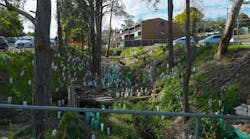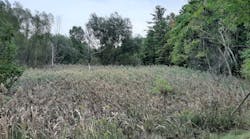Environmentally Friendly Army Tank Trails
“Environmentally friendly” is not the image that usually comes to mind when thinking about Army training and the Abrams Main Battle Tank. But believe it or not, building an environmentally friendly tank trail is just what one Army installation in El Paso, TX, did. Using a grid confinement system, the Army Air and Missile Defense Center at Fort Bliss, TX, completed a road to support military training. The project’s objectives were to achieve trafficability and promote the Army’s four environmental pillars: compliance, prevention, restoration, and conservation. Through the use of Geoweb, erosion control planning, and careful project execution, project objectives were exceeded on all counts.
The Environment
El Paso and southern New Mexico are located in the northern third of the Chihuahuan Desert, north of the United States and Mexican border near Juárez, Mexico. Juárez and El Paso are collocated on opposite banks of the Río Grande River. The climate is semiarid, receiving 9-13 in. of rainfall per year, depending on location and orographic effect. The regional aridity, combined with industrial, ground-disturbing activities, contributes significantly to regional dust pollution levels. Both the city and county of El Paso are nonattainment areas for air quality. The city of El Paso is a nonattainment area for PM10, particulate matter smaller than 10 microns, and the county is a nonattainment area for ozone depletion. Both the city and county are nonattainment areas for carbon monoxide. Across the state line in nearby New Mexico, Doña Ana County is under a Natural Events Action Plan to reduce PM10. The entire region is concerned with air-quality issues.
Fort Bliss headquarters are inside the city limits of El Paso, with most of the 1.1-million-ac. training area in nearby southern New Mexico. Fort Bliss’s northern boundary adjoins the Army’s 2-million-ac. White Sands Missile Range test facility in New Mexico. The project site is in the Doña Ana County portion of the New Mexico training area, 25 mi. north of El Paso. The site is a low-elevation area, on the perimeter of Playa Lake, which is a biologically sensitive area. The project road intersects with Owen Road, the installation highway between El Paso and White Sands Missile Range headquarters. Adjacent to the project site, on Owen Road, is the Army’s Doña Ana Range Camp (DARC), containing barracks and permanent maintenance facilities. Military personnel use the base camp to perform vehicle maintenance and to marshal military convoys up-range into the open training areas.
The DARC is in close proximity to the project site and partially downwind. The project site, or tank trail, is a major tracked- and wheeled-vehicle convoy access route out of the DARC to cross Owen Road and travel into the up-range training area. This tank trail is known as the Doña Ana Main Supply Route, or DA-MSR. The dominant vegetation surrounding the project site consists of mesquite and saltbush shrubs and dropseed grasses.
The facility directly downwind from the project site is the New Mexico National Guard Maneuver Area Training Equipment Site (NM MATES). It is the largest facility at the DARC and regularly uses the DA-MSR for both equipment evaluation and training-area access. The NM MATES experienced both trafficability problems and fugitive dust associated with the tank trail.
The Problem
The native subgrade underlying the 1,700-ft.-long project site is a silt-dominated soil. The surrounding area of the project site is at low elevation, with a deep silt deposition. Silt soils are small, fine-grained, nonplastic, cohesionless soils. They do not compact well, they remold easily under pressure, and they are poor load-bearing soils. When wet, silt soils become runny and lose bearing strength. Trafficability can be a concern in dry or wet silt soils. The heaviest vehicle using the DA-MSR is the 62-ton Abrams Main Battle Tank. Other tracked vehicles, such as the Paladin Self-Propelled Howitzer and ammunition carriers, as well as wheeled vehicles, such as 5-ton trucks, convoy through this trail. Traffic loading during peak periods can be high.
Under this traffic loading, the trail’s bearing strength failed and impasses occurred, especially during wet periods. In attempts to avoid getting stuck, traffic sought out bypass routes through the surrounding vegetation. Over time, the many bypass trails caused severe environmental degradation. The result was reduced vegetation and ground cover, reduced soil nutrients, altered infiltration patterns, and reduced wildlife habitat. Bypass trailing and its subsequent large-scale removal of the natural barriers to wind and water erosion resulted in proportionate increases in fugitive dust. The area surrounding the project site demonstrated a severe trend toward desertification. Dust devils and storms blew suspended PM10 materials in all directions.
The trafficability problems on the tank trail and the resulting bypass trails were causing an increase in regional air pollution, potential sedimentation in Playa Lake, dust pollution at the DARC, and visibility problems on Owen Road. The increases in fugitive dust were also creating some dangerous and uncomfortable secondary effects. At the DARC, increased respiratory illnesses, allergy problems, and asthmatic inflammatory conditions were noted, and wind-borne bacteria were also making people ill. Vehicle maintenance and cost were affected from dust in the filter units and fuel lines. During strong wind, visibility along Owen Road was dangerously reduced, increasing the potential for accidents. Clearly some action needed to be taken to provide adequate trafficability, restore the environment, and reduce erosion.
Fort Bliss’s Use of Geoweb
In 1998 Fort Bliss acquired a few truckloads of the geosynthetic Sand Grid, or Presto Geoweb Cellular Confinement System. These excess Geoweb sections were originally acquired by the Army for use during Desert Storm, but they were not needed and were eventually released for other uses. In 2000, Fort Bliss made road repairs in silt-dominated soils using Geoweb. These sites were low areas with deep silt deposition where water would not drain away. Three sites, totaling 1,800 ft., were repaired. Because wheeled vehicles were the only traffic at these sites, and because of the type of fill material available, the repairs achieved surface stabilization and load support. Geotextile fabric was placed onto the travel way, the Geoweb sections were placed on top, and a 2-in.-minus gravel was used as fill and overfill. The fill material was adequate to serve as the wearing surface. The repairs at all three sites worked well, and no more trafficability problems have occurred there since the repairs were made.
The DA-MSR site presented a much more difficult challenge than the earlier sites because trafficability needed to be achieved for convoy operations by one of the Army’s heaviest pieces of equipment, the Main Battle Tank. In addition, the road needed to be repaired in the existing location with minimal environmental disturbance. Because of the area’s low elevation, there would be long periods of standing water, which would weaken the subgrade significantly. For the DA-MSR, Geoweb was used to provide base-stabilization load support, rather than a surface stabilization as in the previous projects.
Construction Methods for the DA-MSR Site
A major planning goal of the project was to minimize disturbance to the existing vegetation. Loss of vegetation as a barrier to wind and water erosion was already a problem. Additional vegetation loss would only increase the erosion potential. The existing roadbed width of 20 ft. was sufficient to accommodate a 16-ft.-wide Geoweb base. Because traffic generally travels in only one direction at a time on the DA-MSR, the roadbed was constructed 18 ft. wide. Grader operators reduced the subgrade 1 ft. below the grade line, pushing dirt to the shoulders to hold the Geoweb and infill in place. A 6-oz. nonwoven geotextile was overlapped and laid along the length of the repair. The geotextile was laid onto the shoulders to reduce potential fill migration at the edges of the cellular confinement system.
Good-quality fill materials were available for use in repairing the DA-MSR roadbed. A 1-in.-minus base course was used for infill and overfill of the Geoweb cells. A 0.75-in.-minus rigid base was then placed atop the base course to serve as the wearing surface. The final step was to crown (bank) the rigid base, then wet and compact it. The surrounding bypass trails were barricaded to force use of the repaired road segment and begin the recovery process.
Discussion and Results
One use of Geoweb or Sand Grid is stabilizing expedient roads using native materials. The cells contain the native materials within the cell walls, providing cohesion to cohesionless soils. Load is passively distributed throughout the grids. The geotextile fabric laid beneath the cellular confinement system prevents material migration. Even though quality materials were available for use in the project, a few cells were filled with the native silt soil to allow performance comparison of the native material and the higher-quality material. After the cells containing the silt soils were covered with the compactable rigid-base wearing surface, no performance differences were immediately apparent. The analogy that best describes the materials’ performance is packing a fine-grained soil into a coffee can; once the native material is confined, bearing strength for load support can be achieved. However, these few sections will be further monitored for subsidence.
Geoweb is a cost-effective and functional answer to silt-dominated soil problems on Fort Bliss training-area roads. The fort plans to continue using Geoweb to solve these load-support problems. Fort Bliss will be able to further reduce installation cost in future applications by using native material for infill and putting quality materials in place for wearing surfaces.
The final product, the DA-MSR Geoweb-supported roadbed, resembles a floating solid structure in a sea of silt. Trafficability requirements were achieved, and military training was enhanced. The project furthered the aims of the Army’s four environmental pillars. Regional dust pollution, sedimentation to Playa Lake, and local fugitive dust all will be decreased from the recovery and conservation of the vegetation surrounding the project site. Environmental conditions at the DARC and wildlife habitat in the area will also benefit from the project’s long-term effects. Even the hardened, raised roadbed itself acts as a barrier to the blowing dust by helping dissipate the dust before it reaches the DARC.

